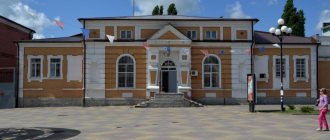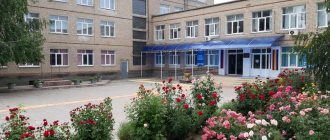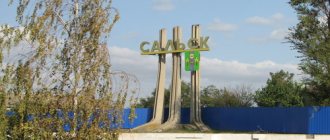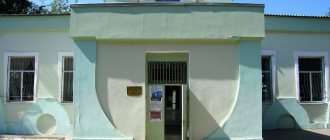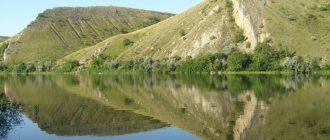Archaeological Museum-Reserve "Tanais"
Archaeological Museum-Reserve "Tanais".
Khutor Nedvigovka, Rostov region. Photo: Arestov Andrey Pavlovich / photobank “Lori” “Tanais” is one of the first archaeological reserves in Russia. It is located in the Nedvigovka village of the Rostov region. Almost five thousand years ago, the border between Europe and Asia passed here and a Greco-Scythian-Sarmatian-Maeotian city stood. Its traces were discovered by Soviet archaeologists in 1955.
The site of Tanais was the northernmost point of ancient civilization. Monuments of different cultures have been preserved here - from the Paleolithic to the 19th century. All exhibitions are outdoors. In the museum you can learn how the Tanait defended themselves from the enemy, cultivated wheat and fished. More than 140 thousand ancient objects tell about this, including a marble altar, ceramic dishes, women's jewelry, ancient fabrics of the 14th century and other artifacts.
RAZDOR ETHNOGRAPHIC MUSEUM – RESERVE
Razdorsky archaeological monuments, included in the Razdorsky Ethnographic Museum-Reserve, are located on the territory of the village of Razdorskaya, the villages of Kanygin and Pukhlyakovsky, as well as a section of the Don River with a floodplain and terraces. This is a whole series of prehistoric settlements and sites of ancient people who inhabited these fertile lands in ancient times. This combination of living conditions was once especially valuable in the steppe zone, providing the inhabitants of these places with an abundance of fuel in the coastal floodplain forests, significant fish stocks, a watering hole for livestock and a fairly large concentration of wild animals in this region. Not a place, but a paradise under the Sun! Is not it? Therefore, it should not be surprising that these places have been inhabited by people since ancient times. There is a lot of material and physical evidence about this, collected over a long period of time by archaeological scientists, amateur archaeologists and other curious amateurs. People like you, or me, or anyone else. But seriously, the Razdor Ethnographic Museum-Reserve includes several archaeological monuments, the origin of which goes not only into the depths of centuries, and even downhill, but into the very wilderness, this very hidden “tundra” » millennia. Such a collection of different events, differing from each other in chronology and place in history, one might even say, a pile of evidence and messages from our distant past, albeit partly forgotten, but nevertheless, this does not make it any less real. And all this is in Razdorskoye. Here and now! Here you go!
Centuries flashed through the sky like a comet,
When we multiply two easily by a third,
And in that Razdorsky they were so closely intertwined,
Yes, not centuries, but a host of millennia!
Yes, it is the millennia that makes up the historical identification of the archaeological monuments and finds found in this territory.
- These are, first of all, the archaeological monuments of Razdor I, whose origins date back to the Neolithic from the 5th millennium BC. to the 10th century AD
- These are archaeological monuments of Razdor II, approximately dating back to the Pre-Pottery Neolithic of the 7th – 5th millennium BC.
- This is Rakushechny Yar, representing the Neolithic-Chalcolithic of the 7th – 3rd millennium BC. and Porechny Island.
How to look deep into those centuries, but not centuries at all, but deep into millennia...
And, as was said earlier, there are more than 9,000 thousand such archaeological sites in the Rostov region. And I would like to see everything. Or touch, or at least read all about them. It is possible to embrace the impossible, but only if you really want to. How to comprehend, by the way. But sometimes, comprehending the past is probably the same as jumping from a plane without a parachute. Almost wrong, almost fatal, but how much do we want to fly freely? Or free fall? Down to the very center of knowledge of our being. The same one that has long ago irretrievably sunk into the abyss of oblivion. Or non-existence...Alas, but forever...Such realities...Such life...
Novocherkassk Holy Ascension Cathedral
Novocherkassk Holy Ascension Cathedral. Novocherkassk, Rostov region. Photo: Yakovlev Andrey Alexandrovich / photobank “Lori”
Novocherkassk Holy Ascension Cathedral is a historical monument of the Don Cossacks. It is the third largest in Russia after the Cathedral of Christ the Savior and St. Isaac's Cathedral. The cross on the main dome is decorated with rock crystal crystals with diamond edges. They shine so brightly that the cathedral is even called “the second sun of the Don.”
Inside the temple, the walls are painted with frescoes, and the choirs (balconies) are decorated with paintings on scenes from the history of the local Cossacks: “Ermak’s preparations for the campaign in Siberia”, “Grant of the Tsar’s Banner under Tsar Mikhail Fedorovich in 1614”, “Azov Seat in 1641” and many other. The lower temple-tomb was consecrated in honor of the Intercession of the Most Holy Theotokos. Sarcophagi are installed here in which the founder of Novocherkassk Matvey Platov and the heroes of the Patriotic War of 1812 rest: Vasily Orlov-Denisov, Ivan Efremov, Pyotr Baklanov and others.
STAROCHERKASSY HISTORICAL AND ARCHITECTURAL MUSEUM-RESERVE
Years, centuries, and after them millennia passed. The Leventsovskaya fortress fell under the onslaught of unknown enemies. The Elizavetovskoe settlement disappeared. Either because of the stupidity of people, or because of the greed of bloodthirsty neighbors. The ancient city of Tanais was irrevocably captured and destroyed to the ground; apparently the Hellenes had heard enough myths about the invincibility of the Spartans, which they were not at all. And the Razdolsk archaeological miracles showed their face to us, speaking about the frailty of existence, as well as the transience of time. Time is inexorable. For you, and for us, and for them. It is not subject to God alone. Or the Universe. Or our future. Everything is destined, everything is fleeting. The era of the Scythians, Sarmatians and Hellenes has sunk into darkness. And nothing else came out of there. But we stayed. And we are their descendants! One way or another, there will be a future! And it didn’t take long to arrive. Not quietly, it crept up on the era of the harsh times of the dashing Middle Ages. This is how it was in these steppes in the past millennium... It was, but it has already passed... All that remains are glimpses of the memories of some people who left us a memory as a legacy... And for some reason it screams... And for some reason it does not want to be silent...
One of the most striking archaeological and historical monuments of the late Middle Ages on the Don is the Starocherkassk Historical and Architectural Museum-Reserve, which absorbed and clearly demonstrates all the typical features and characteristics, if not of a new ethnic group in Rus', then at least of a special Cossack culture. It is as a keeper of Cossack antiquity, its monuments and history that this museum-reserve appears before us, which includes the territory of the old city of Cherkassk and the surrounding villages. Many buildings and structures that did not survive the fire that almost completely destroyed the capital of the Don Cossacks, after the confrontation between the Reds and Whites in the Civil War, were successfully restored or recreated by specialists who deeply believed that the history of the Don region is inextricably linked with Cossack culture. For this, archaeologists also had to work hard, who, as a result of titanic efforts, dug up the remains of houses, household items and household items of the Cossack village that had sunk into the abyss of time. Thanks to them, as well as the efforts of the entire Don region and the Soviet Government, which fully supported the idea of establishing such a museum on the Don, an entire museum complex was created, called “Starocherkassky”. In general, if you look a little into history, the fate of the once former capital of the Don Cossacks was not the most rosy. The Don constantly flooded Cherkassk, the fire destroyed it almost completely, and the battles of the red and white almost finally put a big end to its existence. In a word, bad luck and that's all. Complete and irrevocable fifth point. Or almost somewhere nearby. A little, but almost. A miracle saved me. It happens.
Time stamps tickets to Heaven,
The clang of death voices is heard,
Could you throw yourself into the hands of fate?
Only you, Old tenacious Cherkassk...
The first written mentions of the “Cherkasy town” on the Don date back to 1593. According to Tatishchev V.N., the village was founded under the name “city of Cherkassy”. From 1644 to 1805 Cherkassk was the capital of the Don Cossacks. It was here that the famous Ataman Platov, who went down in history as a hero of the Patriotic War of 1812, was born. Here, and only here, the uprising of Stepan Razin began, and in 1708 the leader of another uprising, Kondraty Bulavin, was killed. Such is the rich history of these either quiet or violent places. And for some reason this very story hits me on the head. Maybe by accident and inadvertently, maybe quite consciously and with the wind in the wind, but strongly... It happens... Sometimes...
The time comes...Falling into the abyss...
Only leaving us the light of hope...
Hold this unyielding ray tightly...
So as not to disappear in the darkness without a trace...
And so as not to perish as a speck of dust in the abyss...
Loudly, desperately just scream...
State Museum-Reserve M.A. Sholokhov
Memorial House M.A. Sholokhov in the Kruzhilinsky farm. Village Vyoshenskaya, Rostov region. Photo: sholokhov.ru
The Mikhail Sholokhov Museum-Reserve is the only state museum of the writer in Russia. It includes a memorial house in the village of Kruzhilinsky, where Sholokhov was born, a house-museum in the village of Karginskaya, where he wrote “Don Stories,” a house in the village of Veshenskaya, in which the writer worked on “Quiet Don” and “Virgin Soil Upturned,” as well as memorial estate where the Sholokhovs lived from 1949 to 1984.
The museum exhibits tell about the life and work of the writer. Among them are personal belongings of Sholokhov and his family: books, manuscripts, photographs, film and sound recordings, documents, illustrations for books and first editions of works. Also here you can see a unique exhibition “Novel in the Open Air”: its exhibits are the farms and villages described in the novel “Quiet Don”.
Historical places of the Rostov region
Cultural tourism in the Rostov region
Traveling to interesting places and visiting cultural sites has been popular since ancient times. The easiest way to find out a little more about what is available in your area is to book a tour from a travel company on our website. Guides offer a wide range of trips for different numbers of days and with different budgets. In addition, such a vacation can be combined with walks in nature. Whatever type of excursion you choose, you will spend your time as interesting as possible.
Experienced guides will take you inside all the monuments and buildings included in the program and tell you their history. Cultural tourism in the Rostov region has a number of advantages:
- you can visit the most interesting historical places in the region and take photographs of them;
- the opportunity to consider the history of the country in new aspects;
- a chance to organize educational, bright leisure time for yourself;
- the opportunity to explore the region;
- low cost;
- the opportunity to meet like-minded people.
It will be interesting to invite friends or relatives to visit historical places in the Rostov region. With them, emotions are brighter and more fun on the road. Also, such an excursion will be an extraordinary emotional gift. It will be able to immerse you in historical action, tell you about the heroism of your ancestors, or delight you with an unexpected ending to the story.
Nature and history are inseparable
Today, a very popular type of recreation is a trip to nature with visits to local attractions. Our guides create routes for tourists that run past famous historical monuments near natural sites. The end point of such a path can be the spacious shore of a picturesque river or lake, where you can pitch a tent and relax for several days, swimming and catching fish. This way, you will be able to see new interesting places and at the same time sleep in a tent listening to the singing of birds.
A professional guide will clearly indicate the direction of the route, indicate what attractions and advantages it contains. If you have a large company, you can develop an individual route. The guide will take into account all the client’s wishes and develop an optimal plan of action for traveling to historical places in the Rostov region.
A trip to the sights of the region is a great way to spend time productively. Such an excursion with children is especially good - kids will be able to get to know the region better and see a lot of new things. Such tours are also popular among young people, couples and the elderly. They are interesting to everyone who likes to relax actively, and not at home on the couch, and the guides on our site are ready to help you go on such a journey.
By the way, many historical places of the Rostov region are known not only for their beautiful architecture and amazing views, but also for the presence nearby of a good spring with healing waters, according to local beliefs. In such a place you can not only learn about stories not described in textbooks, but also be inspired by the extraordinary energy of natural harmony.
Surb-Khach Church in Rostov-on-Don
Church of Surb-Khach. Rostov-on-Don. Photo: Viktor Filippovich Pogontsev / photobank “Lori”
The Surb-Khach Church is one of the most ancient in Rostov-on-Don. It was built according to the design of the architect Ivan Starov at the end of the 18th century. The walls of the temple in the classicist style were decorated with khachkars - ancient stone steles with images of crosses. In 1862, the church was rebuilt, and a two-tier bell tower with a high tent was erected nearby. At the monastery there was a seminary and the first printing house in the south of Russia. Over time, the temple began to collapse, but in 1968–1972 it was restored. The Museum of Russian-Armenian Friendship was opened here.
Today Surb-Khach is an Armenian Apostolic Church. The temple and the surrounding park are located on the right bank of the Northern Reservoir, and a spring flows from under the hill on which it stands. Armenian poets and public figures are buried near the walls of Surb Khach: Harutyun Alamdaryan, Mikael Nalbandyan, Rafael Patkanyan.
All sights of the Rostov region (39)
The lands of the North Caucasus were once inhabited by Scythians, Cossacks, Tatars, Khazars, Sormatians, Armenians and other peoples, who left their traces, which today are called the sights of the Rostov region. Rostov-on-Don is a city of seven seas, in which many temples of various religions are concentrated.
Here are traditional Orthodox complexes: the Rostov Cathedral of the Nativity of the Blessed Virgin Mary - an architectural monument of the 19th century, the noble Alexandria Church of the early 20th century and the famous Trinity Church of the mid-18th century, St. Seraphim and Prepolovenskaya churches, prayer houses - All Saints, St. George, Panteleimon churches and others. Among the attractions of the Rostov region are the Armenian churches in Rostov-on-Don: the Cathedral of St. George the Illuminator - the largest Orthodox Armenian complex in the city, the churches of St. Karapet, St. Nicholas, Surb Khach and the Assumption of the Mother of God. There is also a Catholic church and the Roman Catholic Parish of the Last Supper, a Muslim mosque and several Jewish synagogues located here.
The attractions of the Rostov region are the stunning triumphal arches of Novocherkassk - architectural monuments of the 19th century, dedicated to the victory in the war with Napoleon. In addition, Novocherkassk is famous for its fascinating museums (museum of the history of the Don Cossacks, the memory of the Novocherkassk tragedy, viticulture and winemaking), modern monuments (Reconciliation and Concord, Ermak, Lieutenant General Ya.P. Baklanov, M.I. Platov and others) and delightful cathedrals (Ascension Cathedral, Alexander Nevsky Church, St. George's Church, House of Prayer of Evangelical Christian Baptists).
The following attractions of the Rostov region are concentrated in Taganrog: memorial museum - house of A.P. Chekhov and the museum - the shop of the eminent family, the Taganrog Sea Trade Port - the oldest trading enterprise in the city, a modern monument to Faina Ranevskaya, a large-scale memorial of Glory on the Sambek Heights, a monument in honor of the 300th anniversary of the city, a literary and historical-architectural museum and many other interesting places. In Azov there is a local history museum of the city of the same name, a military monument-boat, the remains of the defensive fortress of Azov - the most visited attractions in the city of the Rostov region.
Monument to Matvey Platov in Novocherkassk
Monument to Ataman Matvey Platov. Novocherkassk, Rostov region. Photo: Boris Panasyuk / photobank “Lori”
The monument to the Don Ataman, hero of the Patriotic War of 1812 and founder of Novocherkassk Matvey Platov is the first sculptural monument of the city. It was installed in 1853 - on the centenary of Platov’s birth. During Soviet times, the monument was destroyed and restored in the 1990s.
The figure of Platov stands on a high pedestal. He was depicted in a general's uniform and a burka - a sleeveless felt cloak. In his left hand the chieftain holds a mace, and in his right hand a saber. The memorial plaque reads: “To Ataman Count Platov for military exploits from 1770 to 1816. Grateful people of the Don."
Monument to Ermak in Novocherkassk
Monument to Ataman Ermak. Novocherkassk, Rostov region. Photo: Oleg Pchelov / photobank “Lori”
The monument to the Cossack ataman, the conqueror of Siberia Ermak, is one of the symbols of Novocherkassk. It is located on Cathedral Square in the city center. The sculpture was erected in the capital of the Don Cossacks in 1904, almost 35 years after the celebration of the 300th anniversary of the Don Army.
The four-meter figure of Ermak is installed on a high granite block, and the total height of the monument is 12 meters. In the ataman’s left hand is a marching banner, and in his right hand he holds the crown of the ruler of Siberia he conquered. Several inscriptions are carved on the pedestal, including the words of the writer and historian Nikolai Karamzin: “Russia, history and the church proclaim eternal memory to Ermak.”
Literary Museum A.P. Chekhov
Literary Museum A.P. Chekhov. The building of the former men's classical gymnasium. Taganrog, Rostov region. Photo: Mikhail Markovsky / photobank “Lori”
The Anton Chekhov Literary Museum is located in Taganrog, in the building of a former men's gymnasium - the oldest educational institution in the South of Russia. The writer studied here for 11 years. Until 1975, a secondary school operated in the building, which bore his name.
The exhibition “The Writer and the Motherland” tells about Chekhov’s life in Taganrog. For the 150th anniversary of the writer’s birth, which was celebrated in 2010, a new exhibition was opened here. In it you can see books that were given to Chekhov by famous artists, performers and musicians, as well as photographs and his personal belongings: a hat, jacket, gloves.
Taganrog Museum of History and Local Lore
Taganrog Museum of History and Local Lore. Taganrog, Rostov region. Photo: Alina Sbitneva / photobank “Lori”
The Taganrog Museum of History and Local Lore was opened on the initiative of Chekhov in 1898. It is located in an ancient building, which was built in the mid-19th century by St. Petersburg architect Andrei Stackenschneider in 1848. The palace belonged to Taganrog homeowner Nikolai Alferaki.
The museum exhibits are located in 15 halls. They talk about the history, culture and archeology of the Don region. Artifacts of the Stone Age culture, which were discovered on the territory of the North-Eastern Azov region, are stored here, as well as items made of bone, bronze and stone found during excavations of the Nizhne-Gnilovsky settlement, one of the six ancient city-states on the coast of Asia Minor.
ELIZAVETOVSKOYE FORTELOGY
The main architectural monument of the ancient period of the Northern Black Sea region is the Scythian Elizavetovskoye settlement, located near the village of Elizavetinskaya, Azov region. The fact that it is Scythian is a rather controversial issue. With the same success, it could be the residence of Konon the Barbarian, as well as the habitat of other fictional characters of world cinema. This is not the point, but something else. As a result of many years of research, experts came to a conclusion about the emergence of this settlement in the middle of the 6th century BC, which ceased to exist around the 3rd century BC. And the reason for his disappearance is still unknown and is also shrouded in the mystery of the past. Located at the intersection of trade routes connecting the Scythian world with the East and the Caucasus, this settlement was a center on the Don in which economic and cultural ties of various ethnic groups were intertwined. And although some believe that this place was once inhabited by warlike Amazons, who burned their breasts to make it easier to draw a bow, in fact, during the excavations of the Elizavetovsky settlement, archaeologists found traces of the existence of several cultures at the same time in this place. These are Scythian, Meotian, Sarmatian and Greek. Perhaps the Amazons we mentioned above also lived here, or their descendants, who retained military skills, but were assimilated by the patriarchal way of life, for example, the same Scythians or Sarmatians. Is this where the secret of the genesis of R1A1 lies? In any case, the finds found during excavations give reason to believe so. Or dream? Time will show…
The legacy of the past is a legacy for the poor,
That's what they say, although they will send us to waste,
Our Elizavetovskoe Settlement,
The story tells us something completely different...
But let's get back to the facts. The territory of the settlement is quite significant in size, occupying an area of approximately 55 hectares, which is quite large for that period. Around the settlement there were defensive fortifications, which consisted of two defensive belts consisting of a deep ditch and high embankments on both sides. Of particular interest is the group of mounds of a large burial ground, bordering the site on the eastern, southern and western sides. One of the groups of burial grounds, consisting of 14 mounds, is called “Five Brothers”. Having carefully examined the tomb found in one of the mounds, archaeologists discovered the remains of a buried Scythian king in gold armor decorated with precious stones. This indicates the status of this settlement, if the mortal remains of the Sarmatian king found refuge here. In addition to the armor, a gold neckband, gold rings with images of griffins pecking the head of a ram, a coral necklace framed in gold, a gold bracelet, a gold plate with images of animals, beasts and crowd scenes from the life of the Greek hero Achilles, and much more were found in this burial. But perhaps the most interesting discovery of these archaeological surveys can be considered the excavated temple of the goddess Demeter and the remains of a warrior buried in a separate mound with all the attributes inherent in a warrior. This is how the hypothesis arose about the Amazons living in this territory. Time will tell how true it is. In the meantime, excavations continue. We just need to wait for them to finish. Then the truth will become the property of everyone!
House-Museum of I.D. Vasilenko
House-museum of the writer I.D. Vasilenko. Taganrog, Rostov region. Photo: tgliamz.ru
The house-museum of the Soviet writer Ivan Vasilenko is located in Taganrog. He lived here with his family from 1923 to 1966, until his death. In this house, Vasilenko wrote several stories for children: “Star”, “The Life and Adventures of Zamorysh”, “Artemka in the Circus”, “The Magic Box”. In 2004, an exhibition was opened here where you can see the writer’s personal belongings, documents, drafts, journals and photographs. Four years later, an exhibition dedicated to the “Cycle of Works about Artemka,” one of Vasilenko’s main children’s characters, appeared in the house. The museum also houses an exhibition of paintings by artist Mikhail Sychev, a friend of Ivan Vasilenko.
Author: Irina Malakhova


